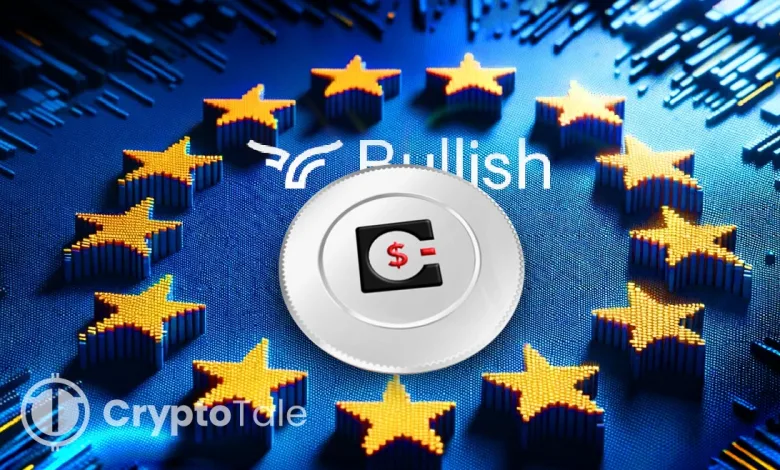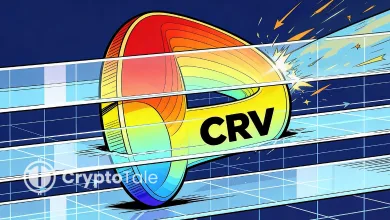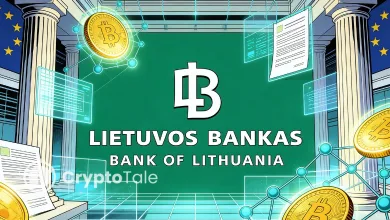Bullish Stablecoin Debuts in Europe as U.S. Waits on Rules

- SG-FORGE’s USDCV debuts on Bullish Europe while U.S. rollout waits for GENIUS Act clarity.
- EURCV processes €40M daily under MiCA with 10–15 exchanges awaiting onboarding access.
- Cross-chain launch on Ethereum and Solana aims to strengthen institutional confidence.
Société Générale’s crypto unit, SG-FORGE, listed its dollar stablecoin, CoinVertible (USDCV), on Bullish Europe on September 22. The listing followed its June deployment on Ethereum and Solana, but U.S. investors remain excluded due to regulatory uncertainty.
The move indicates Europe’s clearer framework under the Markets in Crypto-Assets (MiCA) regulation and shows how banks approach stablecoin adoption differently from private issuers.
Europe Takes Lead and MiCA Market Access
USDCV joins SG-FORGE’s euro stablecoin, EUR CoinVertible (EURCV), which has operated under MiCA rules since 2023. CEO Jean-Marc Stenger confirmed that EURCV processes about €40 million ($47 million) daily, with more exchanges set to onboard minting and burning rights.
Notably, around 10 to 15 platforms remain in the queue for access. This regulated approach contrasts with U.S. conditions, where the GENIUS Act was passed earlier this year but remains incomplete in implementation.
According to Stenger, American investors must wait several months until additional rules are issued. He stressed that a bank subsidiary cannot proceed without clear regulations, unlike private crypto firms such as Circle or Tether.
Bullish Europe Selected for USDCV
SG-FORGE partnered with Bullish Europe, a BaFin-regulated provider licensed under MiCA in Germany, to debut USDCV trading. Marco Bodewein, CEO of Bullish Europe, described the partnership as part of efforts to expand regulated stablecoin offerings for institutional clients. Through this listing, the bank positions its stablecoin for the eurozone demand while awaiting broader global expansion.
The cross-chain deployment of USDCV on Ethereum and Solana also indicates an effort to build institutional confidence. Multiple networks increase accessibility for investors and reduce reliance on a single blockchain. This move aligns with the broader banking sector’s cautious entry into stablecoins, balancing technological flexibility with strict compliance standards.
Related: EU Crypto Market Opens as Gemini and Coinbase Near MiCA Licenses
U.S. and U.K. Align While Banks Expand Globally
U.K. Chancellor Rachel Reeves and U.S. Treasury Secretary Scott Bessent announced a joint Transatlantic Taskforce. The group will explore capital markets and digital asset oversight, producing recommendations within 180 days.
This collaboration could eventually support banks like Société Générale in expanding stablecoin services across both jurisdictions. For now, however, European regulation gives SG-FORGE a head start. Its stablecoins already integrate into digital finance markets, supported by MiCA’s clear requirements on reserve transparency and redemption rights.
The bank’s approach shows how institutional issuers differ from private players. While Circle and Tether dominate in volume, regulated bank-backed tokens may appeal to institutions that demand standardized compliance. This distinction shows how cross-chain deployment and MiCA clarity are influencing adoption trends in Europe first, before reaching the U.S. market.
The development of EURCV under MiCA has already shown signs of broader utility. Recent adjustments removed earlier whitelisting restrictions, enabling free transfer and positioning the euro-denominated token for integration into decentralized finance markets.
SG-FORGE also transitioned EURCV into an Electronic-Money Token (EMT) with approval as an Electronic Money Institution (EMI) from the French ACPR, strengthening regulatory oversight. Beyond Société Générale, global financial firms are exploring similar initiatives.
Payment companies like Stripe and big banks, including Citigroup, Wells Fargo, and Bank of America, have begun working on their own stablecoins. Moreover, JPMorgan confirmed the release of its JPMD coin on the Base blockchain, indicating how traditional finance firms are steadily moving into the regulated stablecoin market.
Meanwhile, USDCV launch on Bullish Europe shows a non-U.S.-first strategy driven by MiCA’s clarity and cross-chain flexibility. By holding back from American markets until the GENIUS Act framework is fully applied, SG-FORGE indicates regulatory caution. Its dual stablecoin approach, with EURCV and USDCV, demonstrates how bank-issued tokens are testing liquidity and adoption under Europe’s emerging rules.




